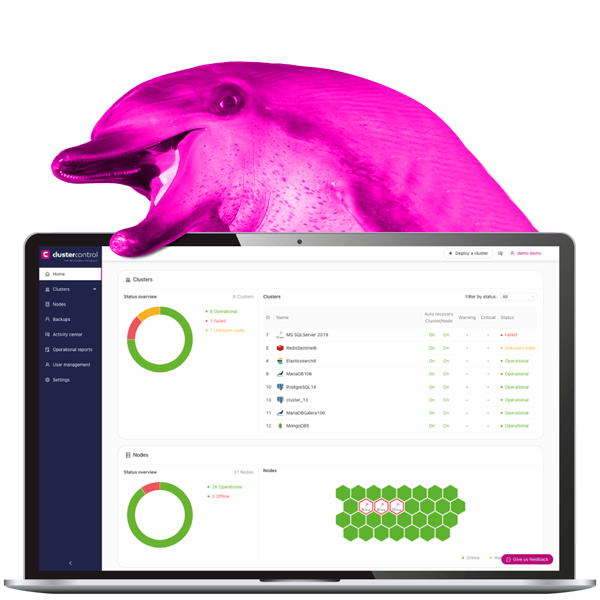Unlock More with ClusterControl + MySQL
Deploy MySQL in One Click
Set up standalone, asynchronous or semi-synchronous replication, Group Replication, or Galera clusters with load balancers.
Enterprise Backup & PITR
Take and restore full, incremental, or partial backups with compression and encryption across environments.
Monitor MySQL Health & Queries
Live dashboards reveal query performance, replication lag, system metrics, and top advisories for tuning and preemptive alerting.
Scale & Manage Without Disruption
Add, or remove MySQL nodes while ClusterControl automates replication setup, load balancing, and failover management.
Enterprise-Level Security Controls
TLS encryption, RBAC, LDAP/AD, certificates management, audit logging — all managed from ClusterControl.
Automatic Failover & Healing
ClusterControl triggers auto-failover, handles proxy failover, and recovers split-brain scenarios — keeping your services uninterrupted.
ClusterControl vs. the Alternatives
ClusterControl is a MySQL cluster manager built for engineers and trusted by enterprises.
| Feature | ClusterControl | Amazon RDS for MySQL |
|---|---|---|
| On-prem & hybrid | X | |
| HA Automation | Built-in | |
| Full control | Limited | |
| Lifecycle automation | Partial | |
| Advanced observability | Basic |
Still Managing MySQL by Hand? Time to Upgrade.
ClusterControl is the MySQL management platform DevOps teams actually want. Built for engineers. Trusted by enterprises. Made for your infrastructure.
It’s been hard to find a unified, feature-rich database cluster management system in today’s market. With Severalnines’ help we’ve been able to deploy a centralized system across Europe and we’re planning to expand our usage of ClusterControl to other territories.
Supported MySQL Configurations
Supported Distributions
Choose from top MySQL distributions and deployment sources to match your performance and scalability needs:
• Oracle MySQL – Official upstream community distribution from Oracle
• Percona Server – A drop-in replacement with enhanced performance and advanced diagnostics
• Percona Server Pro – Percona’s enterprise distribution that supports the Federal Information Processing Standards (FIPS)
ClusterControl also supports installations using official vendor repositories, operating system package managers (e.g., APT, YUM), or custom repository binaries — giving you ultimate flexibility.
Replication & High Availability
Optimize your MySQL infrastructure with flexible, production-ready replication and HA options:
• Asynchronous Replication – Simple and widely used; ideal for read scaling.
• Semi-Synchronous Replication – Reduces data loss risk with minimal performance tradeoff.
• Group Replication – Native MySQL high availability with built-in auto-failover and conflict handling.
• Galera Cluster – Synchronous multi-primary replication for strong consistency and high availability.
Severalnines is Enterprise Ready

Reliable
Zero-downtime operations you can count on.

Secure
Data stays protected, at rest and in transit.

Compliant
GDPR, SOC 2, ISO27001 standards.
Managed MySQL features list
| Licenses | |
| Open Source | |
| Enterprise | |
| Cluster management | |
| Deploy / import cluster | |
| Add / clone / duplicate / remove / decommission node | |
| High availability | |
| Load balancers | |
| Automated failover | |
| Asynchronous / synchronous replication | |
| Backup / restore | |
| Full / incremental / partial backups | |
| Backup compression / encryption | |
| Point in Time Recovery (PITR) | |
| Local / cloud backups | |
| Observability | |
| Infrastructure / database / query monitoring | |
| Dashboarding / alerting | |
| Security / compliance | |
| Role-based access control | |
| Key management | |
| LDAP integration | |
| TLS encryption | |
| Reporting | |
| Audit log |
Choose the CC plan that fits your use case and preferred payment terms
Advanced
self-serve
Includes all features from Advanced
- Deploy 2 to 5 node clusters
- Monthly subscription
- Pay with Credit Card
- Community support
starts at€250per node, per month
€0.35per node, per hour
Advanced
Includes everything from Community
- Load balancers
- Scaling and failover
- Backup and recovery
- Monitoring and alerting
- Database user management
- Business hours support
Custom pricing
Enterprise
Includes everything from Advanced
- CC Ops Centre
- Backup verification
- Ops reports and audit logs
- RBAC & LDAP / Active Directory
- Key management, TLS encryption
- Web / email / phone 24×7 support
Custom pricing
Get the ClusterControl for MySQL One-Pager
Top rated Docs
What about other forks of MySQL?
ClusterControl deploys MariaDB, Percona Server for MySQL, and Oracle MySQL under the “MySQL” heading. Where other forks may work, you should check the databases we support.
When importing an existing MySQL instance, will I lose or break anything?
No. ClusterControl will just include that instance in the console and allow you to manage it, but it won’t stop it nor change any executables or data. Here’s how.
Can ClusterControl restore a MySQL backup and the software, or do I need to install the binaries first?
ClusterControl can restore a complete backup into an empty server with the same OS. All you need is connectivity to the IP and a user.




